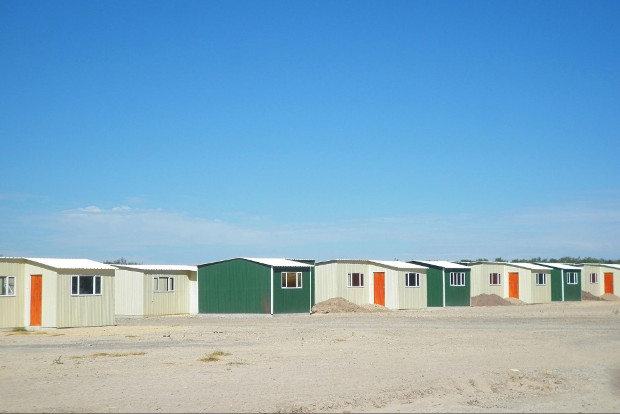
Wolwerivier Incremental Development Area. Photo: Christine Ayela.
18 March 2016
Most poor and working class people are still furthest from centres of economic activity and job opportunities in South Africa’s cities. They are also the furthest away from good schools, healthcare, and recreational facilities. Nowhere is this more evident in South Africa than in Cape Town.
The Western Cape Province and the City of Cape Town’s Spatial Development Frameworks obliges it to address the exclusion of Black, Coloured and Indian people from Cape Town’s CBD and hubs of economic activity. A central pillar to the City of Cape Town’s Integrated Development Plan is the need to create a more inclusive City.
The reality, on the other hand, is that the distribution of affordable housing in post-apartheid Cape Town is far away from the city centre and the mostly white and affluent, neighbouring suburbs. Developments such as Pelican Park, Wolwerivier, Happy Valley, Blikkiesdorp, Wallacedene, Delft, and Atlantis are now home to thousands of poor and working class people.
The argument from the Western Cape Provincial Government is that there is scarcity of well-located public land available for housing. Yet the Provincial Department of Transport and Public Works recently sold a parcel of prime land located in Sea Point, which once housed the Tafelberg Remedial High School, and a block of social housing apartments.
We also doubt the Province and City’s assertions that the Western Cape Government is in pursuit of an inclusive city when those in need for social housing the most, are and have been, pushed out of well-located areas. Two examples of these actions, include the case of Wynyard Mansions where tenants were ‘progressively relocated’ away from Sea Point and De Waal Drive where residents within a particular income bracket are being pushed out to Pelican Park, an area almost 30km outside of the City Centre.
The factor of location and its implications, put aside, questions also arise about the type of housing provided by the City in these far-flung areas.
Temporary Relocation Areas (TRAs) serve the purpose of providing temporary accommodation for households in need of emergency housing, usually after they have been displaced by a situation such as flood, fire or, disturbingly, an eviction. Residents are only meant to live in TRAs for short periods of time while permanent accommodation is being arranged by the government. In reality, these structures have become permanent homes. They are 40m2 one- roomed units made of corrugated zinc sheets, plastic taps and pipes. They get extremely hot in summer and cold in winter.
The City has adapted the TRA concept, by constructing Incremental Development Areas (IDAs), which they defined as ‘a process and product that is quicker to deliver and is premised on being permanent, albeit incremental.’ These too, are located far from the City Centre and access to services and other social facilities. The units are made from the same materials as TRAs, and only come with a promise of upgrading, to be undertaken by either the government or the resident. By calling them incremental development areas the City cunningly avoids the question of temporariness. There is no framework regulating when upgrading must start or be completed. Ultimately this means that residents are housed in temporary structures indefinitely.
People residing in TRAs and IDAs are effectively living in government-funded shacks.
When will City and Province create housing for poor and working-class communities in areas such Sea Point, the City Bowl and neighbouring suburbs, such as Woodstock?
Let us look at Wolwerivier, an IDA located about 32kms from Cape Town and home to over 300 households.
Despite overcrowding in a number of housing units, each unit has its own access to water, sanitation, electricity connections and refuse removal, but not a bath or shower as was initially promised.
What is concerning is that residents are far from necessary services such as healthcare facilities, police stations, schools and, more importantly, places to seek employment.
Currently a number of primary school children on the site are not attending classes, because there is no bus to take them to the closest school, Vissershok Primary, about 13km away.
Despite being notified of the situation by residents and Ndifuna Ukwazi in 2015, the City has only recently requested the names of the affected students. This request has not resulted in transportation being provided.
High school students were also not provided with transport, leading to learners dropping out of school.
Residents also complain that ambulances, fire trucks and the police take too long to get to Wolwerivier in an emergency. A number of units have burnt down before fire trucks arrived on the scene.
Transport is limited to expensive taxis every few hours. Residents spend about R50 for a round trip to Cape Town. Many residents have to choose between putting food on the table or getting into a taxi to try and find employment.
The City’s Human Settlements Directorate, along with the relevant provincial departments, must rethink, redefine, then plan and deliver according to the true and all-round meaning of the terms ‘integrated human settlements’ and ‘inclusive city’. Unless this is done the only “world class” acclamations for Cape Town will be for its natural scenic beauty from tourists while poor residents, constituting almost half the population, continue to live under the exclusion they inherited from apartheid.
View expressed are not necessarily those of GroundUp.